
|
Sale 46
The Millennia Collection
| Lot |
Photo |
Description |
Realized |
Lot 801 |
 |
Russia. Ruble, 1704. Diakov-p.69,9; Sev-152; Uzd-0464. This first ruble of Peter I is struck over a 1655 Jefimok (Rarity-4) and shows very clear remnants of the obverse counterstamps. The original host coin is a taler of Austria of uncertain type, though with time spent in careful examination, this too may be determined. The only other specimen of overstriking on a Jefimok is shown in Spassky (The Hermitage Specimen), but this specimen is better. Extremely rare and desirable. NGC graded EF-45.
Estimated Value $25,000 - 35,000.
(*).
View details and enlarged photos
| Unsold |
Lot 802 |
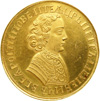 |
Russia. Peter I, 1682-1725. Novodel Ruble struck in Gold, 1705 (Moscow). Fr-76 (62); Sev-12; Bitkin-532; Diakov-page 87, part 1. 44.22 grams. Laureate, cuirassed youthful bust right. Reverse: Crowned, double-headed eagle with scepter and orb. Plain edge. Sharply struck with all details bold, Peter's hair curls in higher than normal relief. The surfaces are fully prooflike on both sides, with the devices softly lustrous to frosty matte and the fields reflective with an almost watery texture. Undoubtedly a high gift of state, the coin has been carefully preserved, with minimal marks or hairlines. The reverse die shows faint radiating cracks. This is one of the most important of all Russian coins!
Struck in gold to the weight of 13 Ducats, 44.22 grams, and created from the dies of the novodel ruble of 1705 (Sev-185), this is the plate coin shown in Bitkin and Diakov which appeared in both the 1977 Soderman and the 1991 Goodman auctions and is the only specimen appearing at public auction in over 25 years. Severin mentions this particular specimen (his number 12) as well as another weighing 40.4 grams, making this one of only two known examples. He also mentions a gold 1707 rouble (no. 18) and a 1723 in 12-ducat weight, each presumably unique. NGC graded MS-63.
Among Peter's numerous reforms, he caused his country's coinage system to change from being the most old-fashioned in Europe to being the most up to date. His was the first coinage to employ the decimal system (dividing the Ruble into one hundred smaller units, of copper Kopecks). Part of his reform involved devaluation, which made, for the first time, the Russian Ruble equivalent in its buying power to the Polish, Saxony and Silesian thalers which had seen such free circulation within the country before. It is said that, when the first Ruble coins bearing Western-style Arabic dates were struck in 1707, it was Peter himself operating the coin press!
Estimated Value $250,000 - 300,000.
Ex Dr. Robert D. Hesselgesser Collection (5/30 - 6/1/05), lot 1751; Goodman Collection (Superior, Feb. 1991), lot 4; and Soderman Collection (Swiss Bank, Feb. 1977); Illustrated in Money of The World, coin 115.
View details and enlarged photos
| Realized
$391,000 |
Lot 803 |
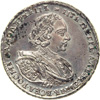 |
Russia. Ruble, 1721 (Moscow). Dav-1655; Sev-519; Uzd-599; KM-157.5. Peter I, 1682-1725. Laureate, draped, and cuirassed bust right. Reverse: Crowned double-headed eagle, with scepter and orb. Minor planchet flaw on reverse edge; also a few scattered surface deposits. A marvelous strike, with only trivial weakness at eagle's breast. Fully lustrous, with proof-like fields. Very Rare in this grade. NGC graded MS-63 Prooflike.
The son of Czar Alexei Michailovitch and Natalia Narishkina, Peter was co-Czar with his half-brother, Ivan V, under the regency of his sister Sophia from 1682 to 1689. After a palace coup to remove Sophia, Peter began his sole reign and commenced his Herculean task of modernizing Russia militarily, technologically, and culturally. Herculean may truly be more apropos than poetic, since Peter stood a burly six foot eight. Even so, considering the internal resistance he had to meet and overcome, his successes appear phenomenal.
Peter was truly a "hands on" administrator. He believed in starting from the bottom and working his way up. He learned shipbuilding from the Europeans he invited to Russia, and even built a ship himself, which he sometimes captained. In 1697, he accompanied an embassy to European courts as a carpenter named Peter Mikhailov. He also served as seaman, soldier, and barber, and surely to the discomfort of his courtiers, he even practiced dentistry.
Peter also sent Russians out to be educated in the West, and in return imported skilled labor, as well as military and administrative experts from abroad. He encouraged smoking, but taxed tobacco. Even the condition of being hairsuite became a point of focus for him. Because European men usually were clean-shaven, Peter became infamous among his tradition-oriented countrymen for taxing the wearing of beards. Also, he modernized the calendar, introduced the use of European style of Arabic numbers, and encouraged private industry and mining. Remarkably, Peter managed to modernize Russia without borrowing money from the state. Instead, he taxed his citizens heavily.
Militarily, his foreign wars were directed to one significant goal, that of obtaining ice free ports for his navies. Obtaining Baltic ports led to the protracted Great Northern War with Charles XII of Sweden. Less successful wars were waged against the Turks in order to acquire access to the Black Sea.
Among Peter's other great reforms, he brought his country's coinage system from being the most old fashioned in Europe to being the most up to date. Amazingly, his was the first coinage to be ordered on the decimal system. Part of his reform involved devaluation. This made for the first time the Russian unit of account, the Ruble, to be equivalent to the Polish, Saxony, and Silesian thalers that had seen such free circulation within the country before. Dividing the Ruble into one hundred smaller units were the copper Kopecks. It is said that when the first ruble coins bearing Western style Arabic dates were struck in 1707, it was Peter himself operating the coin press!
Estimated Value $6,000 - 7,000.
View details and enlarged photos
| Realized
$35,650 |
Lot 804 |
 |
Russia. Ruble, 1727 (Moscow). This unusual variety of 1727 ruble is unlisted in Severin, Diakov, Bitkin and GM. It utilizes the same Moscow mint obverse as Uzdenikov's Pattern-152. Fourteen rivets are counted on the breastplate. The reverse is the wide date variety with small numerals and small crowns as seen on Saint Petersburg issues, with cross-hatching within the oval crown bases. We expect this discovery coin to generate considerable interest among specialists in the series. NGC graded AU-58.
Estimated Value $15,000 - 20,000.
(*).
View details and enlarged photos
| Realized
$32,200 |
Lot 805 |
 |
Russia. Ruble, 1728 (Moscow). Bitkin-19; Sev-972; Uzd-0686; Diakov-110, 34; Dav-1668. Peter II, 1727-1730. Laureate, draped, and cuirassed youthful bust right. Reverse: Crowned double-headed eagle, with scepter and orb. A particularly fine strike, the centers bold and full. Fields remarkably free of any distracting handling marks. A lovely example of this type, with traces of original luster and attractive old tone. NGC graded AU-55.
Peter II was Emperor of Russia from 1727 until his death in 1730. He was the only son of Tsarevich Alexei Petrovich and Charlotte of Brunswick-Wolfenbüttel. He was also the only male-line grandson of Peter the Great.
Estimated Value $5,000 - 6,000.
Ex Dr. Robert D. Hesselgesser Collection (5/30 - 6/1/05), lot 1825.
View details and enlarged photos
| Realized
$8,338 |
Lot 806 |
 |
Russia. Ruble, 1741-SPB. Dav-1676; Sev-1363. Ivan III, 1740-1741. 25.92 grams. Laureate and draped bust of the infant Ivan right. Reverse: Crowned double-headed eagle, holding globus cruciger and scepter. Sharp, even strike, with nearly complete details. A few trivial contact marks in obverse field, otherwise fields remarkably pristine and very lustrous. Fine old-collection toning, a very even medium warm gray, made up of iridescent blues, golds and pale russets. Rare -- and rarer still in this grade. NGC graded MS-64.
Ivan, born in 1740, was just an infant when he was named Tsar. Ernst Buhren was named regent; a German, he was prejudiced against all things Russian, and alienated the Russian people. He was replaced as regent by Ivan's mother, Anna Leopoldovna, a philandering and useless libertine who alienated the Russian army, who then placed Elisabeth, daughter of Peter the Great, on the throne. Her first act was to exile the infant Ivan and imprison him -- he never again experienced sunlight or the company of others. Most of his coins were recalled, so all are rare. This is among the finest known.
Estimated Value $12,500 - 15,000.
View details and enlarged photos
| Realized
$60,375 |
Lot 807 |
 |
Russia, German State -- Holstein-Gottorp. Taler, 1753 (Mannheim). Dav-1353; Cr-4; KM-110: Sev-1890. Karl Peter Ulrich of Holstein-Gottorp, 1739-1762. Rare: only 1,000 pieces struck. Bust right of elegant engraving, with tiny "S" below. Reverse: Crowned double-headed eagle with arms of Russia and Schleswig-Holstein. Lovely, soft pinkish silvery gray toning. A beautiful piece. NGC graded AU-58.
Karl Peter Ulrich's coins bear the title of Grand Duke of all Russia, and in fact he was to become czar of Russia in 1762 (as Peter III), the choice of Empress Elizabeth, but alas he had the misfortune of being married to the brilliant, ambitious Catherine, who soon had him deposed, at which she ruled independently as Empress Catherine II. This tiny mintage of 1,000 coins is ardently coveted not just by Germans and Danes but by Russians as well. An exceptional example, with marvelous details!
Estimated Value $2,500 - 3,000.
Ex Irving Goodman Collection.
View details and enlarged photos
| Realized
$28,750 |
Lot 808 |
 |
Russia. 'Dassier' Ruble, 1757-SPB. Bitkin-189; Sev-1686; Dav-1680. Jacques Dassier portrait type. Elizabeth, 1741-1762. Crowned and draped bust right. Reverse: Crowned double-headed eagle, with scepter and orb. Due to an imperfect planchet, some of the design details are not fully struck up, such as the Czarina's ear, some of the hair above it, and the breast. On the reverse, the left center shield and lower left parts of the eagle are soft because of slight planchet thinness at those points, with the left initial just barely visible. Nevertheless, here is a wonderfully fresh ruble, a beautiful coin with shimmering slightly reflective surfaces, no post-production defects, and resplendent with mint luster. A very choice, even pristine, and fully original specimen having delicate silvery toning. Extremely rare this fine. NGC graded MS-64.
This is a rare portrait type, from dies executed by Jacques Dassier (1676-1763), issued for a few months only. Two reverse dies are known, one with and one without the initials under the eagle. From 1740 to 1745, Dassier was assistant engraver at the Royal Mint in London. After a 3-year sojourn in Russia, where he produced the dies for Elizabeth's silver roubles and her gold ten roubles, he died in 1759 at Copenhagen. His designs are among the most interesting and attractive of the period and now much in demand. This very choice ruble is possibly the finest known of its type.
Estimated Value $25,000 - 30,000.
Ex Dr. Robert D. Hesselgesser Collection (5/30 - 6/1/05), lot 1841; ex Fuchs Sale, April 1996, Lot 255.
View details and enlarged photos
| Realized
$195,500 |
Lot 809 |
 |
Russia. Ruble, 1763-SPB NK. Bitkin-175; Sev-1914; Dav-1683. Catherine II, the Great, 1762-1796. Crowned and draped bust right. Reverse: Crowned double-headed eagle, with scepter and orb. Minor flan flaw in face, otherwise superb and fully lustrous. Exceptionally full and crisp strike, with virtually complete details to the regalia on the eagle's breast. Lightly toned, the fields extraordinarily clean. NGC graded MS-64.
Catherine, although originally just a minor German princess, married Peter of Holstein-Gottorp, who would become Tsar Peter III of Russia. Her original name was Sophie, and she was a Lutheran by birth. When she married Peter in 1745, she changed her name to Ekaterina, and her religion to Russian Orthodoxy. Peter became Tsar in 1762. He was so obviously pro-German in his philosopy and behavior that he became totally repugnant in the eyes of the Russian military. A coup was arranged, and Catherine relaced Peter as head of Russia. Peter appeared almost relieved to rid himself of the burden of rule, and Catherine would reign as Catherine the Great until 1796.
Estimated Value $4,500 - 5,000.
Ex Dr. Robert D. Hesselgesser Collection (5/30 - 6/1/05), lot 1865; ex Goodman Coll., Feb. 1991, Lot 442.
View details and enlarged photos
| Realized
$13,225 |
Lot 810 |
 |
Russia. Ruble, 1797-SM FTs. Dav-1688; Sev-2405; J-926. Paul I. Cross of interlocking "P"s. Reverse: Inscription within frame. Lustrous with delicate silvery toned surfaces. NGC graded MS-62.
Son of Catherine the Great, Paul asscended the throne upon her death in 1796 but was totally opposite in character to his mother. Far less pragmatic and far more principled, he believed more in religion and justice than in progress and advancement. He attempted to get the Russian nobility to adhere to an ancient code of western medieval chivalry. This so angered the nobility that it led to his assassination.
Estimated Value $1,500 - 2,000.
View details and enlarged photos
| Realized
$36,225 |
Lot 811 |
 |
Russia. Platinum 12 Rubles, 1832-SP. Fr-158; KM-C179; Bitkin 1st Ed-44; Sev-607. Nicholas I, 1825-1855. Mintage 1,102. Crowned eagle. Reverse Value and date. Well struck with semi proof like fields. Very Rare. NGC graded AU-58.
Estimated Value $12,000 - 15,000.
(*).
View details and enlarged photos
| Realized
$52,900 |
Lot 812 |
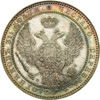 |
Russia (under Poland). Nicholas I, 1796-1855. 10 Zlotych or 1 ½ Rubles, 1833-NG (St. Petersburg). Bitkin-1048; Dav-284; Sev-3029; Cr-134. Crowned double-headed eagle holding sceptre and orb, with a shield having St George & the Dragon motif surrounded by a St Andrew Collar on its breast; provincial coats-of-arms set on the wings. Reverse: Value and date within wreath comprised of laurel and oak leaves. This is quite simply a spectacular specimen, fully struck with perfect surfaces and lovely old iridescent toning, exhibiting a full range of peacock coloring. This Superb Gem Proof is without doubt among the finest known of the type and may well be the finest in existence. NGC graded Proof 67.
These large 10 Zlotys, intended for use in Poland, were first struck at St Petersburg in 1833, continuing uninterrupted until 1841. Their counterparts of similar design, struck at Warsaw, began two years later in 1835 and were also struck each year until 1841, providing a 7-year series for the Polish minted coins versus a 9-year series for the Russian version.
Estimated Value $10,000 - 15,000.
Ex Dr. Robert D. Hesselgesser Collection (5/30 - 6/1/05), lot 1981; ex Virgil Brand Collection.
View details and enlarged photos
| Realized
$50,600 |
Lot 813 |
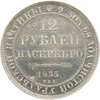 |
Russia. Nicholas I. Platinum 12 Rubles, 1835-SPB. Bitkin-47; Sev-618; Fr-158; Cr-179. Crowned double-headed eagle holding sceptre and orb, with a shield having St George & the Dragon motif surrounded by a St Andrew Collar on its breast; provincial coats-of-arms set on the wings. Reverse: Value and date within a crenelated circle, legend around. Very sharply struck with semi-frosted devices amid brilliant mirrored proof fields -- the detail remarkable considering the hardness of the metal. With a mintage of around 127 pieces, the 1835 is rated R3, with 4 to 9 examples estimated to exist. It can easily be assumed that few, if any, are this choice, especially a proof of near gem quality. NGC graded Proof 65.
All platinum issues appeared during the reign of Nicholas I (1825-55), including some experimental coronation medals and jetons of 1826 and a unique half rouble of the same date using regular dies. The regulation coinage began in 1828 with 3-rouble coins, the 6 roubles coming in 1829 and the 12 roubles added one year latter in 1830. Minting in this metal continued until 1845, when an imperial ukase ordered complete cessation of platinum coinage and a total recall of existing coinage in circulation within a 6-month period due in part to their unpopularity with the public. The minting of 12-roubles coins began in 1830 and these were struck every year until 1845. The mintages ranged from a high of 1,463 pieces in 1831 to only one coin in 1840. Most mintages were fewer than 127, with only three years above that amount: 1831, 1832 and 1833. Proofs exist of several dates, but there seems to be no published record of the numbers struck, although they must be very tiny indeed.
Estimated Value $25,000 - 30,000.
Ex Dr. Robert D. Hesselgesser Collection (5/30 - 6/1/05), lot 1978.
View details and enlarged photos
| Realized
$132,250 |
Lot 814 |
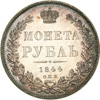 |
Russia. Ruble, 1844-SPB KB. Dav-283; Sev-3457. Crowned double-headed eagle, with scepter and orb. Reverse: Crown over value and date, within. Sharp, velvety devices on mirror fields, blessed by elegant, smokey pinkish gold toning, darker at the edges and richly iridescent with greenish blue. Superb example. NGC graded Proof 66 Cameo.
Proofs are rare, but nearly flawless examples such as this specimen are simply elusive.
Estimated Value $10,000 - 12,500.
View details and enlarged photos
| Realized
$39,100 |
Lot 815 |
 |
Russia. Pattern 5 Rubles or ½ Imperial, 1895-AG. Fr-175; KM-Pn142; Bitkin 1st Ed-309; Sev-548. Nicholas II, 1894-1917. Mintage of only 36 pieces struck. Bust left. Reverse Eagle in circle. Very Rare. NGC graded Proof 62.
Estimated Value $20,000 - 25,000.
(*).
View details and enlarged photos
| Realized
$253,000 |
Lot 816 |
 |
Russia. Ruble, 1896 (Star * Paris). Dav-293; Sev-4034; Y-59.2. Nicholas II, 1894-1917. Bearded head left. Reverse: Crowned double-headed eagle, with scepter and orb. Single star on edge. Sharp, satiny devices on mirror fields. Light smokey-russet toning, tending to blues and violets in the recesses. NGC graded Proof 64.
Nicholas was a weak monarch at a time when great strength was needed. He was unprepared to ascend the throne upon his father's death, and was just as unprepared to lead Russia at the time of World War. His policies led to great loss of men and materials, and terrible shortages of food and supplies for the people. The Russian Revolution was as much a result of his incompetence as it was a result of the revolutionary spirit of the times.
Estimated Value $4,500 - 5,000.
View details and enlarged photos
| Realized
$13,800 |
Lot 817 |
 |
Russia -- Siberia. Novodel Copper 10 Kopeks, 1779-KM. B-528; Bitkin-H948. Edge-1. Catherine II, 1762-1796. Crowned monogram, within wreath of laurel and reed leaves. Reverse: Crowned oval cartouche bearing value and date, supported by flanking rampant foxes, on trapezoidal base. Sharp, full strike, with lustrous, immaculate, reddish brown surfaces. (Too large for holder). NGC graded MS-67 Red & Brown.
These large Russian coppers were minted in Kolyvan (KM), the most eastern of all the Russian mints, close to Outer Mongolia. Never a large city or major commercial area, Kolyvan was deemed necessary as a Russian mint because of the immense size of the territory of Siberia. It was easier to move the minting machinery to Kolyvan than to ship the finished products from the far western Ekatrerinburg.
Estimated Value $1,000 - 1,250.
View details and enlarged photos
| Realized
$2,520 |
|
|